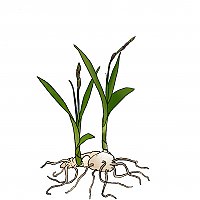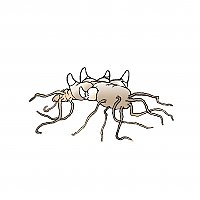No products in the cart.
Seasonal Cycle for the Bletilla Striata
 January-March January-March |
 April-May April-May |
 June-July June-July |
 October-December October-December |
Just right for “beginners”, these terrestrial orchids are among the simplest to maintain in the garden.
Growth Phase of a Bletilla Striata
The new Bletilla shoots appear during April and open out into a bouquet of leaves in the spring. The flowering is at its best at the beginning of the summer (June, July).
Following the flowering, the foliage, fairly persistent, remains green at least until October before fading and disappearing completely. Bletilla then go into their winter dormancy. At the end of November, when the leaves have faded, the floral scape can be cut, preserving a stem height of 5 cm.
Over the years and following the successive growth and dormancy cycles, Bletillas not only become stronger but also multiply, thanks to the annual appearance of new shoots.
Winter Dormancy
During the winter, the plant persists in pseudobulb form; make sure that the latter is not too wet in order to avoid any rotting.
Bletilla are fairly rustic orchids, so they should be protected by mulch in winter in the regions where the temperature regularly descends below -20°C to -25°C. Apart from such areas, no protection is necessary. Among Bletillas, the striata species is the most vigorous.
Planting
In the garden, a humus-rich, light, aired and well-drained soil is recommended. You can air your soil using compost for hardy perennials. For an optimal result, add 20% of lava stone (vulca) in order to maintain good moistness in summer and to ensure good drainage during the winter. Indeed, more than intense frost, it is excess water in winter that proves to be the pseudobulbs’ worst enemy.
If your soil is too compact or contains too much clay, we would advise you to create a planting pocket. Dig a trough of approximately 40cm, cover the bottom of it with a drainage layer (lava stones or small pebbles) and fill it with the substrate recommended above.
Bletilla can also be kept in pots to embellish your terraces. Be sure however to select a large enough pot (minimum diameter 30-40cm) in order to avoid impeding the development of the new peripheral shoots that will appear during the following year. Water regularly from April to September, and then leave your plants to rest. In winter, in harshly cold regions (-25°C), shelter your pots from severe frost in a cold place (maximum 5°C).
Exposure
In the garden, the ideal site will be sunny or semi-shaded. It is important not to allow the substrate to dry in summer.
Fertilisation and Pesticide Treatments
The application of potassium-rich manure during the vegetation phase (April to July) will encourage the proper development of the pseudobulbs in summer and consequently will ensure an excellent production of floral scapes during the following spring.
If necessary, protect the tender young shoots from slugs, during their emergence in the spring.
